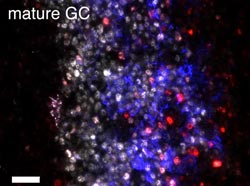MDC Researchers Solve Puzzle of B-Cell Lymphoma Development

In germinal centers (here: whithin the spleen of a mouse) immune cells learn to fight pathogens with high specificity. Dr. Dinis Calado and Dr. Klaus Rajewsky now identified subpopulations of B cells at the germinal centers which express the proto-oncogene Myc (red). They showed that Myc is essential for the formation and maintenance of germinal centers. Their findings have implications for the pathogenesis of B-cell lymphomas.<br><br>(Photo: Dinis Calado/ Copyright: MDC)<br>
Now, Dr. Dinis Pedro Calado and Dr. Klaus Rajewsky of the Max Delbrück Center (MDC) have identified subgroups of B cells in germinal centers in which the proto-oncogene Myc, a critical regulator of cellular proliferation, is highly activated.
They showed that the Myc gene in these subpopulations is essential for the formation and maintenance of the germinal centers. Their findings also shed light on the origin of B-cell lymphomas derived from B cells at the germinal center (Nature Immunology, DOI:10.1038/ni.2418)*.
The Myc gene is a key regulator of cellular proliferation and is frequently involved in chromosomal translocations in human lymphomas derived from B cells at the germinal center reaction. Such translocations, seen in roughly 10 percent of diffuse large B-cell lymphomas and almost all cases of sporadic Burkitt lymphoma, juxtapose Myc and enhancers in immunoglobulin loci, leading to deregulated Myc expression.
These observations have puzzled researchers for many years because translocations of this gene can only take place in those cells where Myc is active. “However, Myc is thought not to be expressed in B cells at the germinal center reaction, the progenitors of most B-cell lymphomas,” Dr. Rajewsky said. So the question was: if B cells at the germinal center reaction do not express Myc, how can they give rise to B cell lymphomas carrying Myc translocations?
Germinal centers are located in the lymphatic organs such as the spleen, lymph nodes and Peyer’s patches in the intestinal wall. In the germinal centers the B cells are confronted with antigens and quickly proliferate. For the immune system to be able to cope with the huge variety of antigens, B cells must modify their DNA through mutation (somatic hypermutation) and recombination (class-switch recombination). However, the fast proliferation together with the ongoing DNA modifications may increase the occurrence of errors, which makes the malignant transformation of B cells at the germinal center reaction probable. “B-cell lymphomas are the most common type of human lymphoid malignancies. They mostly originate either from B cells at the germinal center reaction or from B cells that have passed through the germinal center reaction,” Dr. Calado and Dr. Rajewsky pointed out.
What then is the role of the Myc gene? How can Myc be highly activated through translocations in B-cell lymphomas although it is not active in healthy B cells of the germinal center reaction? Dr. Calado and Dr. Rajewsky have now found an answer to this question. They identified subpopulations of B cells located in the germinal centers in which the Myc gene is activated. They also showed that c-Myc is essential for the formation and maintenance of the germinal centers. When they knocked out the Myc gene in B cells they could show that germinal centers could not be formed or maintained.
“The MYC-positive germinal center B-cell subpopulations are probably at high risk for malignant transformation. Our work has direct implications for the understanding of the pathogenesis of human germinal center-derived B-cell lymphomas carrying MYC chromosomal translocations and therefore can contribute to a better understanding of how these lymphomas occur,” Dr. Calado and Dr. Rajewsky said.
*The cell-cycle regulator c-Myc is essential for the formation and maintenance of germinal centers
Dinis Pedro Calado1,2, Yoshiteru Sasaki3, Susana A. Godinho4, Alex Pellerin1, Karl Köchert2, Barry P. Sleckman5, Ignacio Moreno de Alborán6, Martin Janz2,7, Scott Rodig8, & Klaus Rajewsky1,2
1Program of Cellular and Molecular Medicine, Children's Hospital, and Immune Disease Institute, Harvard Medical School, Boston, Massachusetts, USA. 2Max Delbrück Center for Molecular Medicine, Berlin, Germany. 3Department of Molecular and Cellular Physiology, Graduate School of Medicine, Kyoto University, Kyoto, Japan. 4Department of Pediatric Oncology, Dana-Farber Cancer Institute, Department of Cell Biology, Harvard Medical School, Boston, Massachusetts, USA. 5Department of Pathology and Immunology, Washington University School of Medicine, St. Louis, Missouri, USA. 6Department of Immunology and Oncology, National Centre for Biotechnology, Madrid, Spain. 7Hematology, Oncology and Tumor Immunology, Charité, University Medical School, Berlin, Germany. 8Department of Pathology, Brigham and Women's Hospital, Boston, Massachusetts, USA.
Contact:
Barbara Bachtler
Press Department
Max Delbrück Center for Molecular Medicine (MDC) Berlin-Buch
in the Helmholtz Association
Robert-Rössle-Straße 10; 13125 Berlin; Germany
Phone: +49 (0) 30 94 06 – 38 96
Fax: +49 (0) 30 94 06 – 38 33
e-mail: presse@mdc-berlin.de
Media Contact
More Information:
http://www.mdc-berlin.de/All latest news from the category: Life Sciences and Chemistry
Articles and reports from the Life Sciences and chemistry area deal with applied and basic research into modern biology, chemistry and human medicine.
Valuable information can be found on a range of life sciences fields including bacteriology, biochemistry, bionics, bioinformatics, biophysics, biotechnology, genetics, geobotany, human biology, marine biology, microbiology, molecular biology, cellular biology, zoology, bioinorganic chemistry, microchemistry and environmental chemistry.
Newest articles

Superradiant atoms could push the boundaries of how precisely time can be measured
Superradiant atoms can help us measure time more precisely than ever. In a new study, researchers from the University of Copenhagen present a new method for measuring the time interval,…

Ion thermoelectric conversion devices for near room temperature
The electrode sheet of the thermoelectric device consists of ionic hydrogel, which is sandwiched between the electrodes to form, and the Prussian blue on the electrode undergoes a redox reaction…

Zap Energy achieves 37-million-degree temperatures in a compact device
New publication reports record electron temperatures for a small-scale, sheared-flow-stabilized Z-pinch fusion device. In the nine decades since humans first produced fusion reactions, only a few fusion technologies have demonstrated…





















